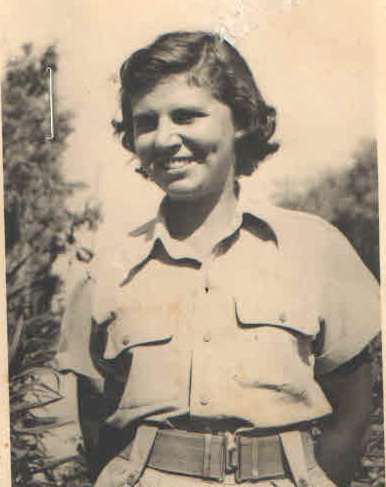
TZIPORA YIZRAELI, born FRANCES MILLER
I was born in Chicago, USA, on 29th March 1923. Eventually, as a teenager, I became involved in Zionism by joining the Hashomer Hadati movement with the intention of eventually making aliyah as a chalutza.
Early in 1948 I had completed three months of preparation on their Hachshara farm at Monouche Junction, New Jersey, and purchased my ticket for Haifa on the Marine Carp, calling at Alexandra in Egypt, Haifa, and Beirut.
When the young group of volunteers heard me speaking English, they insisted that I join them. Their fare had been paid by the Land and Labor Organization. I was immediately issued with a new ticket and the money I had paid for my ticket was refunded into a New York Bank.
The majority of the passengers were Arabs who were due to disembark at Alexandra and Beirut. Of the 75 Jewish men, about 30 were young volunteers from the USA, Canada, Mexico and elsewhere, hoping to join in the fight for a new Jewish State. Others were Palestinian Jews. Of the 18 Jewish women, about 5 intended to join a kibbutz, while others were returning home, some with children.
The Marine Carp was a semi-converted World War II Liberty ship, and the accommodation was frugal. The women and children were accommodated in cabins with two tiers, with three bunks each. The men were accommodated in large bays with racks of pipe metal-framed steel spring bunks. By tacit agreement, all the Jewish men were given one bay to themselves.
Sailing through the Atlantic in the rough seas, most of the passengers were seasick. Later, whilst cruising through the calm Mediterranean, excitement mounted amongst the Jewish passengers with the impending declaration of a Jewish State. Celebrating was spontaneous as the passengers began to sing and dance.
At this stage, the concerned Arab passengers protested and forced the captain to head directly for Beirut. On our arrival there, the Lebanese immigration officials and soldiers examined our luggage. The men were separated and taken out of the reception hall. The women remained there all night. Those needing the bathrooms were escorted by soldiers.
Very much later, in Israel, we learned that the men were transported by trucks to an old military barracks at Baalbek and held as prisoners for some six weeks. After protests by the USA State Department, they were eventually released and returned to New York, stopping at Sicily on a subsequent return voyage of the Marine Carp.
The women were allowed to continue the journey, and we arrived in Haifa on 15th May 1948. The volunteers amongst us were sent to the Tel Litvinsky military absorption camp, and then billeted at the Panorama Hotel at the bottom of Allenby Street. While we were there we were taken to the nearby Mograbi Square and instructed in the basic principles of radar by South African Yetta Golombick.
On 22nd June mobile loudspeakers ordered us to return to the hotel because of the shooting and shelling at the beached Etzel ship the “Altalena.”
After this training we were billeted in a large tent outside of Kibbutz Glil Yam, today almost in the center of Herzliya. There we operated the primitive equipment in pairs in regular shifts, one girl watching the radar screen while the other was outside observing the skyline so that she could advise the operator to move the antenna in the direction of an Egyptian plane, if one was seen.
Around October 1948 we were transferred to the radar station at Givat Olga. Previously it had been a British post which had been blown up by the Etzel underground movement the previous year, before the declaration of the Jewish State.
One day my partner Alexandra and I spotted several images resembling large hot dogs on the screen. We reported this to headquarters and the Air Force sent an aircraft to investigate the area. Eventually we heard that what we had seen were clouds full of electricity, and later our meteorological section predicted that there would be stormy weather two days later.
When the Air Force Administration discovered that I had experience with the IBM punch-card system in statistics at the USA Montgomery Ward in Chicago, and also at the Watertown Arsenal in Boston, I was transferred to the Statistics Department. The officer in charge was Shamir. We received 500 lirot which was paid to a Chaimis, a private contractor, to make diskettes for all the Air Force Machalniks to have their names translated from English to Hebrew.
At the time, in 1949, the pay for all Air Force Machalniks ground personnel was 40 lirot per month, paid by a person called Shil’a through a special fund from England.
In November 1949, already working as a civilian, a set of IBM machines arrived in Tel Aviv. With my previously-mentioned experience, I together with two officers, one named Zev Unger, recorded all the payments of civilian workers of the IDF. I punched code numbers and printed their monthly incomes in Tel Aviv, and then took them to the IBM printer in Jerusalem. Whilst in Jerusalem I used to sleep at a hotel that was then next to the Palestine Post.
Having married a member of Kibbutz Sha’ar Hagolan shortly after the war, I lived on the kibbutz. Now, at the age of 92, I live in the Beit Hadar special care home for kibbutz veterans.
Source: Tzipora Yizraeli with the aid of Machal Chief Researcher Joe Woolf.

